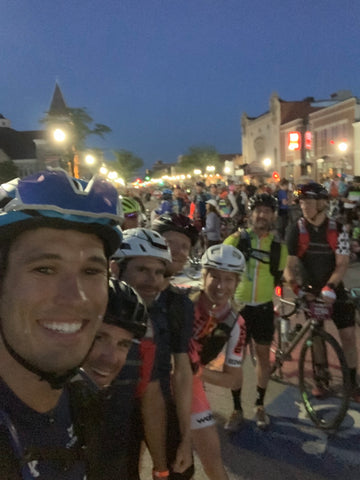
Unchained Melody: A Story of Love, Lube and Messy Relationships
Endurance cycling events require months of preparation, training, and intense gear scrutiny and selection. With durations and distances ranging from 100km to several days, the wrong choice of equipment can cost hours and a chance to cross the finish line. While cyclists spend hours researching frames, tires, and drivetrain components or spend hundreds of dollars on expensive ceramic bearings and pulleys that reduce friction and maximize efficiency, most riders don’t put much research into their chain lube. With so many brands on the market the choices can be overwhelming. Is one lube really that different from another? In the last ten years I’ve tried just about everything; from the industry stalwarts to boutique start ups. Some worked well, others were disappointing. I’d switch loyalties on the recommendation of friends, only to be disappointed and switch back to an old standby. But, like any relationship it’s easy to settle until you find “the one.”

During long races it’s usually necessary to either pull over every fifty miles at a pit stop for a drivetrain wipe down and re-lube, or, hit the chain with a squirt from the water bottle to silence it temporarily. Some of the filthier races I’ve done include Dirty Kanza 200, Crusher in the Tushar, Gravel Worlds, Shenandoah 100, True Grit 100, 12 Hours of Temecula, Belgian Waffle Ride, and the Leadville 100... just to name a few. Stopping at aid stations, if they’re even available, is not only costly from a time perspective, but mentally and physically damaging as well. Try getting on and off a bike after seven hours of racing and cramps are setting in. It’s not comfortable. Also, I never had a clue what kind of chain lube the neutral support team would be using. I’ve come out of aid stations with a sparkling drivetrain, only to look down and see a greasy, black chain five minutes later. Or, I’ve had a perfectly clean chain go haywire after a creek crossing as the water and dust formed a paste on the cassette and chain.
 Like most cyclists, I thought a noisy drivetrain was inevitable during endurance rides; until I discovered SCC Tech. I’ve used dozens of chain lubes over the last decade of racing and most worked well for one condition or another, but I never found anything that functioned well in every conditions until I decided. to #RideItSlick. Last season on a recommendation I gave their "drivetrain treatment" a try. I didn't notice much of a difference at first, but the more I rode the better it worked. After my first ride the chain was completely black and I was discouraged, thinking it was attracting more dirt than it was shading. I wiped it down before my next training session. After repeating this process a few times I noticed that after I finished riding, my chain was just as clean as when I’d started. Strange. I stopped cleaning my chain and would forget about it for days at a time. Later I would find out that the polarity in the formula attracts the formula to the metal, while the detergent draws out existing contaminants within the micro-crevices of the chain and pushes them to the surface where they are easily wiped away. Once the old lube and trapped dirt has been expelled, voila! Clean chain. Other chain lubes trap dirt, dust, and grit in the lubricant where they act like sandpaper by increasing friction and wearing down your chain, chainrings, and cassette.
Like most cyclists, I thought a noisy drivetrain was inevitable during endurance rides; until I discovered SCC Tech. I’ve used dozens of chain lubes over the last decade of racing and most worked well for one condition or another, but I never found anything that functioned well in every conditions until I decided. to #RideItSlick. Last season on a recommendation I gave their "drivetrain treatment" a try. I didn't notice much of a difference at first, but the more I rode the better it worked. After my first ride the chain was completely black and I was discouraged, thinking it was attracting more dirt than it was shading. I wiped it down before my next training session. After repeating this process a few times I noticed that after I finished riding, my chain was just as clean as when I’d started. Strange. I stopped cleaning my chain and would forget about it for days at a time. Later I would find out that the polarity in the formula attracts the formula to the metal, while the detergent draws out existing contaminants within the micro-crevices of the chain and pushes them to the surface where they are easily wiped away. Once the old lube and trapped dirt has been expelled, voila! Clean chain. Other chain lubes trap dirt, dust, and grit in the lubricant where they act like sandpaper by increasing friction and wearing down your chain, chainrings, and cassette.
The summers in SoCal mean dusty fire roads that can leave drivetrains crunchy within a matter of minutes, but this is not the case with SCC Slick. It wasn’t until the first weekend in June when I was halfway through Dirty Kanza 200 that I knew I’d never use another chain lube again. The previous year had been a drivetrain disaster after neutral support applications of various products didn’t hold up to dust, river crossings and cow manure. This year with SCC Slick my chain links were literally sparkling clean after mile 105. My crew tried to grab my bike and put it in the work stand. “No, please don’t” I said, but they insisted, “I really really don’t want you to touch my chain” I pleaded. Finally they conceded, thinking I'd gone mad.
By the end of the race my body was beyond destroyed. Twelve hours of hammering through every condition imaginable had wrecked me, but not my drivetrain. In the last five miles my hands were so numb I could barely mash them against the shifters, but when I did the chain jump was smooth and flawless. No crunch. No grind. No hesitation. And, while there’s many other things I’d do differently from a training, nutrition, and pacing standpoint, I finally got my chain lube dialed in.

After an impressive performance in Kansas I opted to use SCC Slick again for the Leadville 100 MTB two months later. It was a race I was familiar with having already ridden it four times. In all my years at Leadville I’d always stopped for a drivetrain wipe down at Twin Lakes on the way back from Columbine. Not this year. I didn’t need to. My chain was silent. The drivetrain crunch that always haunted me up Powerline? Gone. The paved section to the top of St. Kevin’s? Silent. It had confirmed everything I’d experienced at Kanza. But don’t take my word for it. Grab a blue bottle and put it to the three ride challenge. It’s cheapest and easiest way to reduce friction and improve your drivetrain performance in any riding environment.
Keep it Slick,
Ryan Steers
